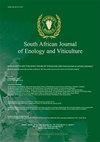Effect of Kaolin/Defoliation Combined with Dry Ice on Lambrusco Red Wine Production to Constrain the Effects of Climate Change
IF 1.1
4区 农林科学
Q4 FOOD SCIENCE & TECHNOLOGY
引用次数: 1
Abstract
Since viticulture is affected considerably by climate change, it is imperative to encourage research on newstrategies in order to constrain these critical effects on the composition of berries and the quality of wines.A multi-strategy approach composed of (i) kaolin application on foliage, (ii) late tree defoliation and (iii)cryomaceration of grapes with dry ice was evaluated in the production of Lambrusco Salamino wines.Physical, chemical and sensory analyses were carried out on the sample set, including the control wines.In general, cryomaceration with dry ice proved to be a winning choice to lower alcoholic strength (roughly5%). In addition, the wines showed an increase in anthocyanin content by approximately 17%, while thecontent of catechins, flavanols and hydroxycinnamic acids decreased. Consistent with the increase in theanthocyanin content, an increase in colour indices and sensory colour intensity scores was observed. As forthe aromatic profile, 2-phenylethanol showed an increase of approximately 18% in the treated wines while,in parallel, a lower content of C6 alcohols and volatile fatty acids was observed. The multiple adaptationstrategies put in place in the present study show an alternative way to mitigate the severe effects of climatechange on wine production, and to face changing consumer demands.高岭土/落叶结合干冰对兰布鲁斯科红葡萄酒生产的影响,以限制气候变化的影响
由于葡萄栽培在很大程度上受到气候变化的影响,因此必须鼓励对新策略的研究,以限制这些对浆果成分和葡萄酒质量的关键影响。在Lambrusco Salamino葡萄酒的生产中,评估了一种多策略方法,包括(i)在树叶上施用高岭土,(ii)晚树落叶和(iii)用干冰对葡萄进行冷冻浸渍。对包括对照葡萄酒在内的样品组进行了物理、化学和感官分析。一般来说,用干冰冷冻浸渍被证明是降低酒精浓度(大约5%)的最佳选择。此外,葡萄酒的花青素含量增加了约17%,而儿茶素、黄烷醇和羟基肉桂酸的含量下降。与茶花青素含量的增加一致,观察到颜色指数和感官颜色强度得分的增加。至于芳香特征,2-苯基乙醇在处理过的葡萄酒中显示出约18%的增加,同时观察到C6醇和挥发性脂肪酸的含量较低。本研究中采用的多种适应策略显示了一种替代方法,可以减轻气候变化对葡萄酒生产的严重影响,并应对不断变化的消费者需求。
本文章由计算机程序翻译,如有差异,请以英文原文为准。
求助全文
约1分钟内获得全文
求助全文
来源期刊
CiteScore
2.50
自引率
7.70%
发文量
1
审稿时长
>36 weeks
期刊介绍:
The South African Journal of Enology and Viticulture (SAJEV) publishes full-length original Research Papers, Research Notes and Review Papers on all subjects related to enology and viticulture. The SAJEV does not accept articles published in, or submitted to, other journals.

 求助内容:
求助内容: 应助结果提醒方式:
应助结果提醒方式:


